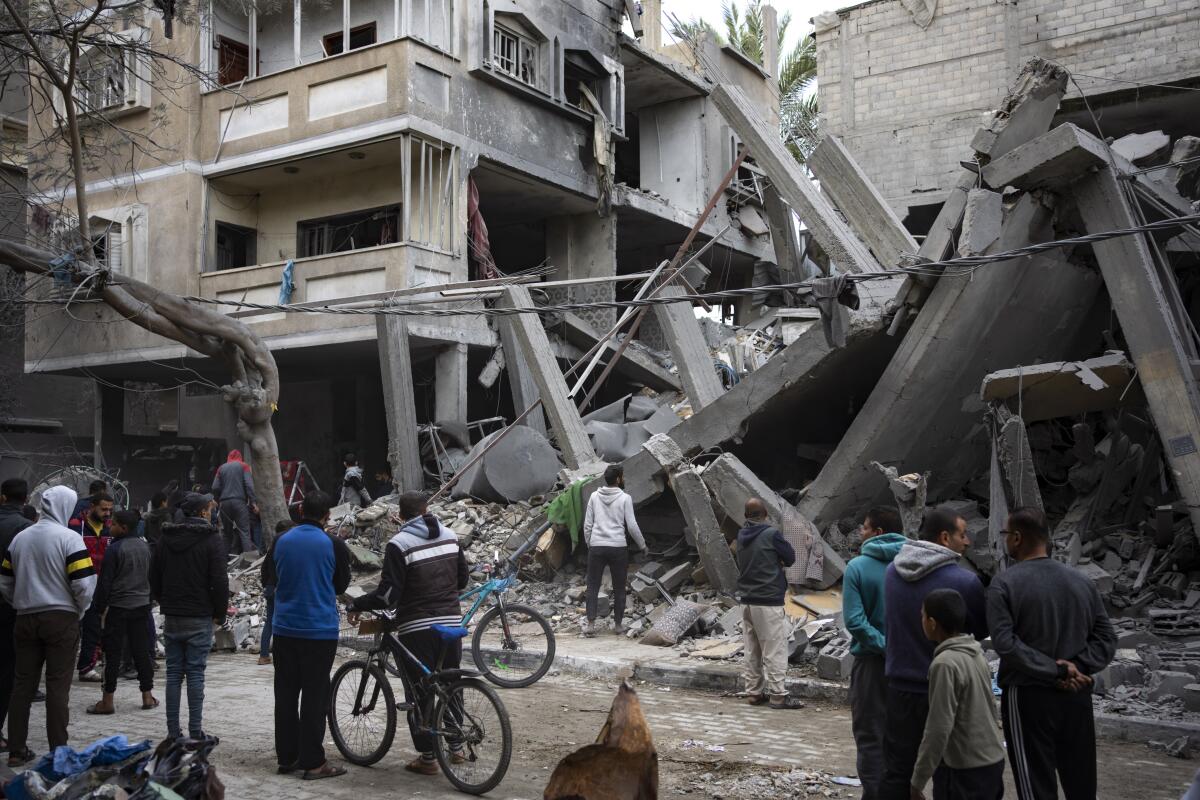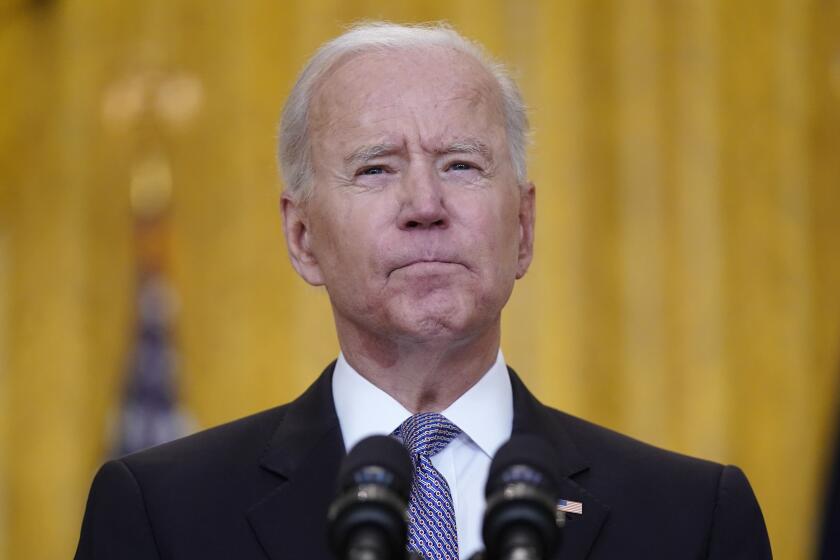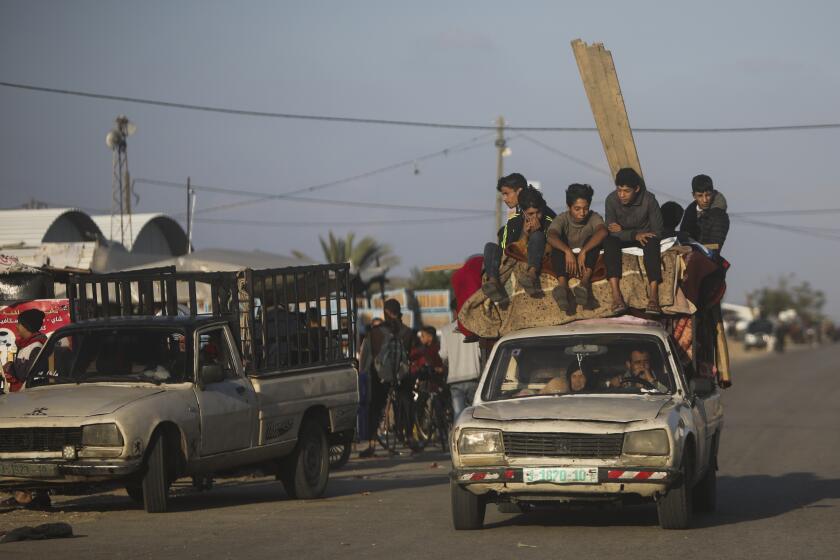Palestinians describe bodies and ambulances crushed in Israel’s ongoing raid at Gaza’s main hospital

- Share via
RAFAH, Gaza Strip — Palestinians who fled an ongoing Israeli raid in and around Gaza’s main hospital described days of heavy fighting, mass arrests and forced marches past dead bodies in interviews Sunday.
Israel’s military says it has killed over 170 militants and detained about 480 suspects in the raid on Shifa Hospital that began Monday, calling it a heavy blow to Hamas and other armed groups it says had regrouped in the compound.
The fighting also highlights the resilience of Palestinian armed groups in a heavily destroyed part of Gaza where Israeli troops have been forced to return after a similar raid in the earliest weeks of the war.
Kareem Ayman Hathat, who lived in a five-story building about 100 yards from the hospital, said he huddled in the kitchen for days while gunfire and explosions caused the building to shake.
Early Saturday, Israeli troops stormed the building and forced dozens of residents to leave. He said men were forced to strip to their underwear and four were detained. The rest were blindfolded and ordered to follow a tank south as blasts thundered around them.
The Biden administration is frustrated on two fronts over Israel’s war in Gaza. Russia and China vetoed a U.S. cease-fire resolution as Blinken met with resistance from Netanyahu.
“From time to time, the tank would fire a shell,” he told the Associated Press from another hospital where he has sought shelter. “It was to terrorize us.”
The head of Israel’s southern command, Maj. Gen. Yaron Finkelman, has called the Shifa raid a “daring, tricky and most impressive operation,” saying it will end “when the last terrorist is in our hands, alive or dead.”
Israeli jets on Sunday launched several strikes near the hospital.
Shifa Hospital had largely stopped functioning following the November raid. After claiming that Hamas maintained an elaborate command center inside and beneath the hospital, Israeli forces exposed a single tunnel leading to a few underground rooms. They also said they found weapons in parts of the hospital.
Gaza City, where Shifa is located, suffered widespread devastation in the early days of Israel’s offensive, launched after the Oct. 7 Hamas attack that triggered the war. Israeli forces have isolated northern Gaza since November, and hardly any aid has been delivered in recent weeks.
Experts said last week that famine is imminent in northern Gaza, where over 210,000 people are suffering from catastrophic hunger.
The White House says President Biden expressed “support” for a cease-fire in a call to Israeli Prime Minister Benjamin Netanyahu Monday, the eighth day of Israeli-Palestinian fighting.
A day after standing near some of the estimated 7,000 aid trucks waiting to enter Gaza and calling the starvation a “moral outrage,” U.N. Secretary-General Antonio Guterres in Egypt called for an immediate humanitarian cease-fire along with the release of hostages held in Gaza. “Looking at Gaza, it almost appears that the four horsemen of war, famine, conquest and death are galloping across it,” he said.
Gaza’s Health Ministry said five wounded Palestinians trapped at Shifa Hospital had died without food, water or medical services. The World Health Organization’s director-general, Tedros Adhanom Ghebreyesus, described conditions as “utterly inhumane.”
Jameel al-Ayoubi, among thousands of people sheltering at Shifa when the current raid began, said in a phone interview that tanks and armored bulldozers had plowed into the hospital courtyard, crushing ambulances and civilian vehicles. He saw tanks driving over at least four bodies of people killed early in the raid.
Israel’s military said Saturday it had evacuated patients and medical staff from Shifa’s emergency department because militants “entrenched” themselves in the building. It said it set up an alternative site for seriously wounded patients.
Abed Radwan, who lived about 200 yards from the hospital, said Israeli forces stormed all area buildings, detaining several people and forcing the rest to march south. As he walked, he saw bodies in the streets and several flattened homes.
Israeli forces struck the southern Gaza town of Rafah twice overnight, sowing fear in one of the last places where civilians can seek refuge.
“They left nothing intact,” he said from a relative’s house in central Gaza.
Israel’s military early Sunday also stormed the al-Amal and Nasser hospitals in the southern city of Khan Yunis amid “very intense shelling,” the Palestinian Red Crescent Society said in a statement. The Israeli military announced operations in Khan Yunis targeting Hamas infrastructure, saying it “eliminated terrorists at close range using tank fire.”
Now in its sixth month, the war has killed at least 32,226 Palestinians, according to Gaza’s Health Ministry. It does not distinguish between civilians and combatants in its toll but says women and children make up around two-thirds of the dead.
Among the latest killed were at least seven people, including three children, when an Israeli airstrike hit a house in Rafah overnight, according to health authorities.
Israel says it has killed over 13,000 militants, without providing evidence. It blames civilian casualties on Hamas, accusing it of using schools, hospitals and residential areas.
More than 80% of Gaza’s population of 2.3 million have fled their homes, with most seeking refuge in the southernmost city of Rafah, which Israel says will be the next target of its ground offensive. Prime Minister Benjamin Netanyahu has rejected calls from the United States and others to avoid launching a major ground operation there, calling it essential for defeating Hamas.
Israeli forces struck the southern Gaza town of Rafah twice overnight, sowing fear in one of the last places where civilians can seek refuge.
The Hamas-led Oct. 7 attack across southern Israel killed some 1,200 people, mostly civilians, and took scores of people hostage. Hamas still holds an estimated 100 hostages and the remains of 30 others. Most of the rest were freed in exchange for the release of Palestinian prisoners in November.
The United States, Qatar and Egypt are trying to broker another cease-fire and hostage release.
Over the border from Gaza on Sunday, Jews celebrated their most joyful of holidays, Purim, the biblical story of how a plot to exterminate Jews in Persia was thwarted as an affirmation of Jewish survival.
The war has stoked instability across the region, including a low-intensity conflict between Israel and Lebanon’s Hezbollah militant group. An Israeli airstrike hit a car in the Lebanese town of Soueiri on Sunday, killing a Syrian construction worker, according to Lebanese state media.
Overnight, the Israeli military said it struck a Hezbollah weapons manufacturing facility in Baalbek city in northeastern Lebanon. Local officials said three people were wounded. Hezbollah later announced it fired 60 missiles across the border in response. There were no reports of casualties on the Israeli side.
Shurafa and Magdy write for the Associated Press. Magdy reported from Cairo. AP writer Abby Sewell in Beirut contributed to this report.
More to Read
Sign up for Essential California
The most important California stories and recommendations in your inbox every morning.
You may occasionally receive promotional content from the Los Angeles Times.













